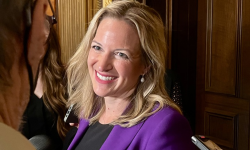Poverty rises in Michigan: State is now 13th nationwide

- Poverty rate in 49 of state’s 83 counties rose in 2022
- Michigan’s rate, 13.3 percent, is the 13th highest in the nation, up from 18th
- Rising inflation, not matched by wage hikes, have put greater pressure on people, officials said
Many Michigan residents — including families with children — continue to grapple with poverty, with rates rising in over half of the state’s counties, according to census figures released last week.
From rural Michigan to the state’s most populous county, Wayne, poverty rates inched up in 2022: to 13.3 percent, from 13 percent inx 2021 and 12.6 percent in 2020, when the rate fell as pandemic aid poured into families’ bank accounts.
The rate increased in 49 of 83 counties, and Michigan is among 16 states that experienced two years of increases.
The overall rate is now 13th among states, up from 18th in 2021. Nationwide, the rate held steady at 11.5 percent.
“It’s not surprising,” said Lisa Chapman, director of public policy for the Michigan Coalition Against Homelessness.
Inflation led to rising rents (up to $1,367 for a one-bedroom apartment, from $1,100 in 2020) and other increases. Chapman said the coalition saw an 8 percent increase in homeless people, she said, rising to over 32,400 in 2022.
Food pantries have reported increased demand as inflation — though falling — has kept prices far higher than they were three years ago.
“People don’t have a lot of cushion,” Chapman said, adding that families have to choose what bill to pay. “It’s tragic.”
The U.S. Census Bureau took inflation into account when it set new poverty thresholds.
For an individual living alone, the 2022 threshold was $14,880 — 8 percent higher than the $13,788 threshold in 2021. For a family of four with two kids under 18, the threshold was $29,678, also up 8 percent from $27,479.
So if someone was just above the poverty line and did not get at least an 8 percent bump in income, they could have fallen into poverty.
Average weekly wages in Michigan rose just 3.2 percent from mid-2021 to mid-2022, according to data from the U.S. Bureau of Labor Statistics.
The rate for children under 18 remained relatively stable, with 17.8 percent in poverty in 2022, up from 17.6 in 2021. But that slight increase pushed the state to the 12th highest child poverty rate in 2022, up from 19th in 2021.
The 2022 rates vary widely across the state, from over 20 percent in Lake, Wayne and Mecosta counties, to under 10 percent in 17 counties, including Macomb, Oakland, Ottawa and Livingston counties.
Luke Shaefer, the director of Poverty Solutions at the University of Michigan and author of two books on poverty, said much of Michigan’s poverty is linked to the state’s long reliance on the auto industry.
Related:
Michigan population panel files recommendations. Now the hard work begins
In Michigan, 1 in 4 kids go to school outside district, as choice expands
Michigan personal income plummets to lowest in history compared to nation
“Michigan has often sort of experienced economic retractions a little bit (more). There's been a bigger impact on poverty because our economy has historically been less diversified than some of our peer states. We have had all of our eggs more in the basket of autos, so when we have economic slowdowns, we're just less diversified so we see the bigger impact.”
The bump in poverty occurred as the state’s overall economy remained relatively stable: Unemployment rates in the state, at 4.1 percent in October, have been below 5 percent for over a year. But the state still lags the nation — the U.S. rate was 3.9 percent in October — and ranks 40th in jobless rate.
Shaefer said lawmakers in Michigan should choose to follow the “incredible success” of the temporary bump in the federal child tax credit, which he said drove down child poverty, food insecurity and bad credit to historic lows during the pandemic.
Minnesota enacted one that provides $1,750 per child for those with low-enough incomes. Shaefer said Michigan could ease poverty rates with a similar program and called it “the easiest, boldest, and most effective strategy to prevent and reduce child poverty.”
In March, Gov. Gretchen Whitmer signed a bill increasing the earned income tax credit in the state, which would boost incomes of the low-income families by an average of $600 a year.
— Staff writer Robin Erb contributed
See what new members are saying about why they donated to Bridge Michigan:
- “In order for this information to be accurate and unbiased it must be underwritten by its readers, not by special interests.” - Larry S.
- “Not many other media sources report on the topics Bridge does.” - Susan B.
- “Your journalism is outstanding and rare these days.” - Mark S.
If you want to ensure the future of nonpartisan, nonprofit Michigan journalism, please become a member today. You, too, will be asked why you donated and maybe we'll feature your quote next time!




